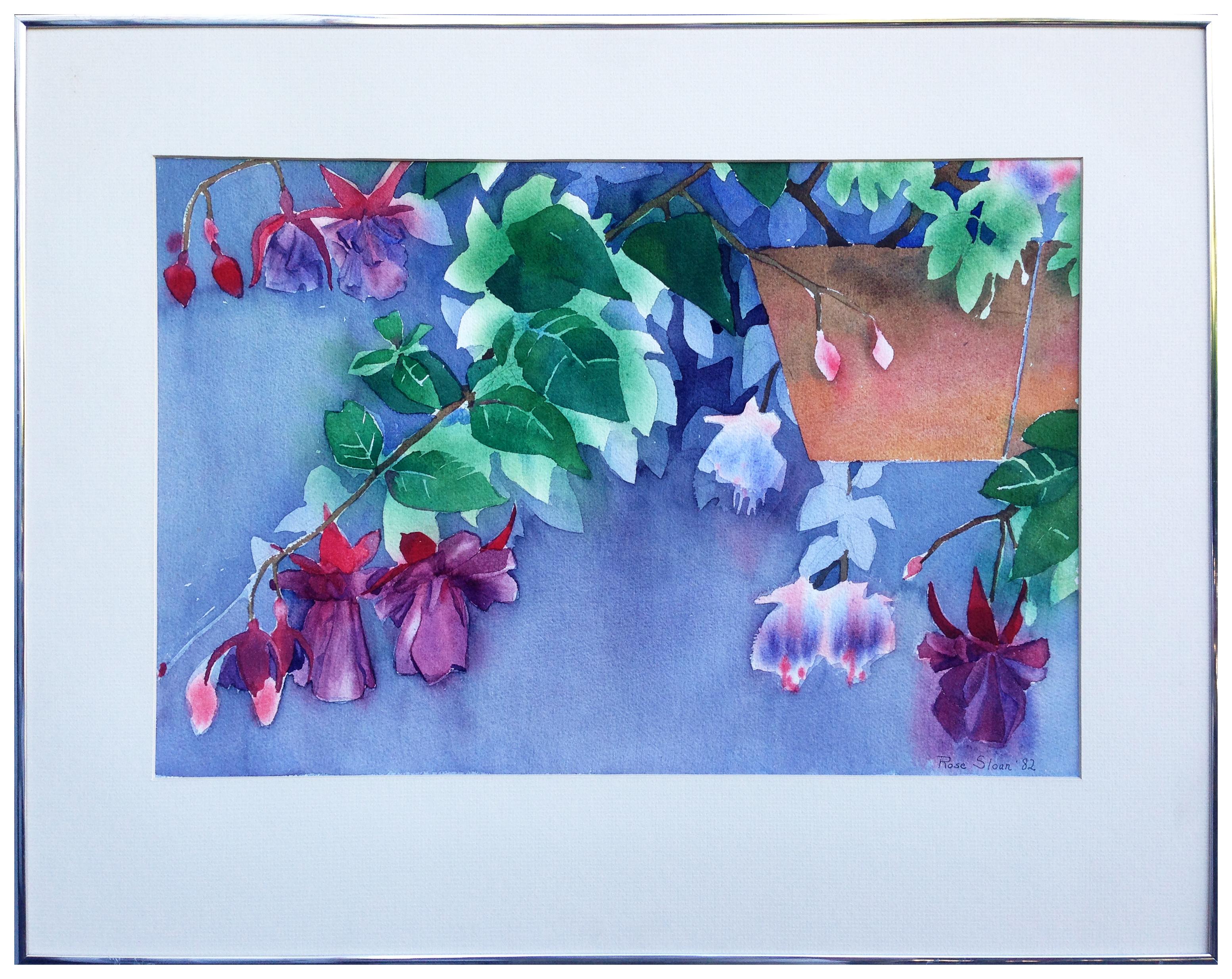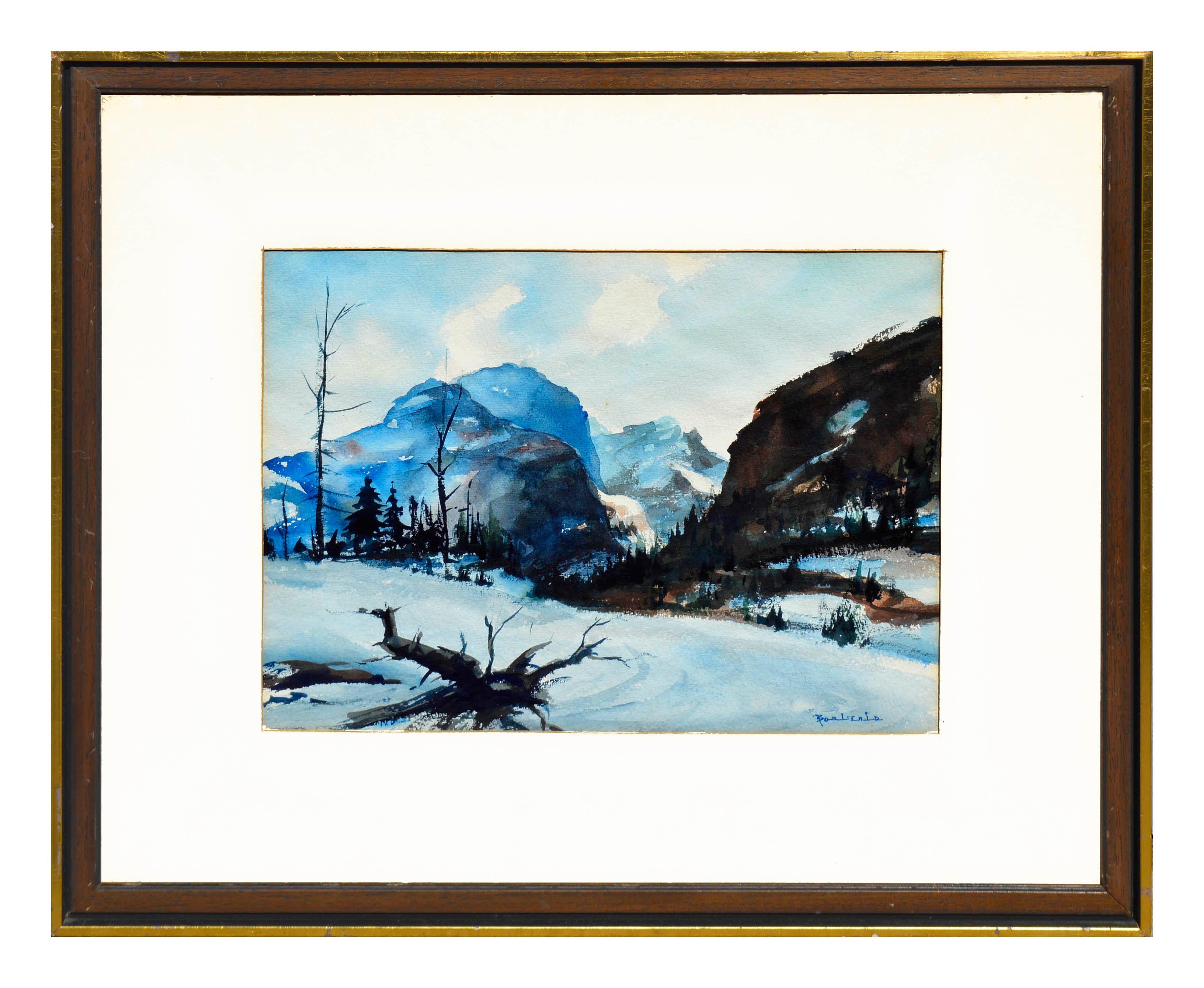Items Similar to Bonnieux Village Luberon France
Want more images or videos?
Request additional images or videos from the seller
1 of 12
Marilyn H HeilprinBonnieux Village Luberon France 2000s
2000s
About the Item
Bonnieux Village Luberon France
Bright and expressive white line woodcut in watercolor of Bonnieux Village Luberon France by Marilyn Heyman Marilyn H. Heilprin, (American, 1926-2020). Heilprin is an author, poet and artist from Bethesda, Maryland. Signed lower right "Marilyn Heilprin, titled lower left "Bonnieux WC 3 (watercolor #3).
Marilyn Heilprin was born in New York City and has a B.A. from Smith College (1948) and M.A. in international relations from The American University (1963). A former research associate, writer and editor for federal agencies and private publishers, she attended writing workshops at Breadloaf, The American University, and Writers' Center in Bethesda, MD. She has published poems in literary journals and was a finalist in the Maryland State Poetry and Literary Society chapbook contests. She co-authored Leo Saal's memoir "Crossings: A Life in Russia and Germany in the First Half of the 20th Century." Feb. 2020, Marilyn Heilprin, 93, a retired editor, writer and researcher who created one of the earliest compendiums of international statistics and organizations.
Image, 9"H x 12"W
Sheet, 14.5"H x 16.5"W
Frame, 15.25"H 17"W x .5"D
Mrs. Heilprin, a former resident of Bethesda, Md., was born Marilyn Heyman in New York City. In the 1950s, she was a researcher and writer on handbooks about Mongolia, Finland, Germany, Austria, Lebanon, Syria and Israel for the Washington-area branch of the Human Relations Area Files, a nonprofit formed by several universities. The "Provincetown Print", a white-line woodcut print. Rather than creating separate woodblocks for each color, one block was made and painted. Small groves between the elements of the design created the white line. Because the artists often used soft colors, they sometimes have the appearance of a watercolor painting.
Marilyn Heilprin, Ruth Cahnmann, George Chung, Susana deQuadros, Susan Due Pearcy, Leo Saal and Ann Zahn are straightforwardly about the figure. One might even say it's about the act and traditions of painting the figure. Dubbing themselves the "Somerset Seven," the group meets periodically to paint from a model at Leon Saal's studio in Somerset, and later at Ann Zahn's studio.
Leo Saal joined the CIA and came to the United States, settling in the Washington area. After retiring from the agency, he devoted himself to art. He was a founding member of such cooperative galleries as the Printmakers Gallery of Washington and Creative Partners in Bethesda. His work also was exhibited in other local galleries, including the Strathmore Hall Arts Center in Bethesda.
White Line Woodcut Printing: Provincetown Printers were a group of artists, most of them women, who created art using woodblock printing techniques in Provincetown, Massachusetts during the early 20th-century. It was the first group of its kind in the United States, developed in an area when European and American avant-garde artists visited in number after World War I. The "Provincetown Print", a white-line woodcut print, was attributed to this group. Rather than creating separate woodblocks for each color, one block was made and painted. Small groves between the elements of the design created the white line. Because the artists often used soft colors, they sometimes have the appearance of a watercolor painting.
Bror Julius Olsson Nordfeldt has been credited with developing the technique, based upon Japanese ukiyo-e woodblock printing, though there is evidence that a lesser-known Provincetown artist, Edith Lake Wilkinson, was making white-line prints in 1913, a year earlier than Nordfeldt's first known efforts.[5] Blanche Lazzell is said to have mastered the technique.
Bill Evaul, a writer for Print Review in the late 1970s, was asked to write an article about "printmaking in Provincetown", but by that time many of the artists were no longer alive. Through research with Myron Stout and meeting with some surviving members, like Ferol Sibley Warthen, he learned the history about the Provincetown Print and later learned how to create works of art with the technique. Since then, he has promoted the white line woodcut technique in his historical research paper "Provincetown Printers: Genesis of a Unique Woodcut Tradition", taught and lectured about the technique, and has created and shown his version of the Provincetown Prints in exhibits.[10]
- Creator:Marilyn H Heilprin (1926, American)
- Creation Year:2000s
- Dimensions:Height: 15.5 in (39.37 cm)Width: 17 in (43.18 cm)Depth: 0.5 in (1.27 cm)
- Medium:
- Movement & Style:
- Period:
- Condition:Excellent paper and acid free mat. Aluminum frame is included as-is, my have some minor surface scratches. Plexiglas included.
- Gallery Location:Soquel, CA
- Reference Number:
About the Seller
5.0
Platinum Seller
These expertly vetted sellers are 1stDibs' most experienced sellers and are rated highest by our customers.
Established in 1986
1stDibs seller since 2014
2,514 sales on 1stDibs
Typical response time: <1 hour
- ShippingRetrieving quote...Ships From: Soquel, CA
- Return PolicyA return for this item may be initiated within 14 days of delivery.
More From This SellerView All
- San Diego Harbor at Night - Nocturnal Coastal Scene with US Navy ShipsLocated in Soquel, CASerene nocturnal seascape by George Fotherly Hargitt (American/Scottish, 1837-1926). The San Diego harbor stretches out in front of the viewer, depicted from a vantage point above th...Category
1920s American Impressionist Landscape Paintings
MaterialsWatercolor, Laid Paper, Gouache
- Blue Hills LandscapeLocated in Soquel, CAGorgeous watercolor painting of a landscape depicting light blue hills with faint pink mountains in the background and vibrant green grasslands in the front....Category
1980s American Impressionist Landscape Paintings
MaterialsWatercolor, Laid Paper
- The Old Monterey Cypress Tree Mid Century LandscapeLocated in Soquel, CAWonderful mid century landscape of an old Monterey Cypress tree in Carmel background in teal hues by Jeanne Manget (American, b. 1913 - 1988), c.1960....Category
1960s American Impressionist Landscape Paintings
MaterialsLaid Paper, Watercolor
- Hanging Fuchsia Still-LifeLocated in Soquel, CABeautiful still-life painting of fuchsias in a hanging basket by Rose Sloan (American, b.1941). Signed and dated "Rose Sloan '82" lower right. Presented in a metal frame and shipped without glass. Image, 13"H x 20"L. Rose Sloan graduated in 1962 with a degree in Art Education from the University of Utah. Sloan now resides in Monterey, California where she teaches art classes and primarily paints plein-air paintings and still lifes.Category
1980s American Impressionist Landscape Paintings
MaterialsWatercolor, Laid Paper
- Yosemite Tuolumne Meadows in Winter LandscapeLocated in Soquel, CAGorgeous watercolor winter landscape of Yosemite's Tuoloumne Meadows by Dorothy Watkeys Barberis (American, 1918-1998). Unframed. Signed "Barberis" lower right. Image size, 12"H x 15"L. Dorothy Barberis was born on September 20, 1918 in Newport News, Virginia. National Association Women Artists, National Arts Club, Salmagundi, New York Artists Equity, Mid-West Watercolor Society, Southwest Watercolor...Category
1970s American Impressionist Landscape Paintings
MaterialsWatercolor, Laid Paper
- Minimalist Mid Century Modern Landscape -- Autumn TreesLocated in Soquel, CAMinimalist mid-century modern landscape of three autumnal trees by M. Lehtio (American, 20th century). Signed "M. Lehtio" and dated "48." Presented in a wood frame and non-glare glas...Category
1940s American Impressionist Landscape Paintings
MaterialsWatercolor, Laid Paper
You May Also Like
- Homestead, Regional American Landscape by Pennsylvania ImpressionistBy Harry Leith-RossLocated in Doylestown, PA"Homestead" is a regional, American landscape by Pennsylvania Impressionist and New Hope School painter Harry Leith-Ross. The painting is a 14" x 19" watercolor on paper, signed "Lei...Category
1940s American Impressionist Figurative Paintings
MaterialsWatercolor, Archival Paper
- Blooming Flower Pots, Watercolor and Gouache over Pencil on White Paper, FramedLocated in Houston, TXBlooming Flower Pots is a Watercolor and Gouache over Pencil on White Paper .It is framed and ready to be shipped. One artists described Santoli's paintings as "Now that is a world class oil painting! Realistic casual brush work. The best I have seen. Delicious !! " Artist Statement: I simply love painting and my goal is to capture sunlight and color so that viewers can enjoy it as well. Eric...Category
2010s American Impressionist Still-life Paintings
MaterialsPaper, Watercolor
- "Train Station, " Max Kuehne, Industrial City Scene, American ImpressionismBy Max KuehneLocated in New York, NYMax Kuehne (1880 - 1968) Train Station, circa 1910 Watercolor on paper 8 1/4 x 10 1/4 inches Signed lower right Provenance: Private Collection, Illinois Max Kuehne was born in Halle, Germany on November 7, 1880. During his adolescence the family immigrated to America and settled in Flushing, New York. As a young man, Max was active in rowing events, bicycle racing, swimming and sailing. After experimenting with various occupations, Kuehne decided to study art, which led him to William Merritt Chase's famous school in New York; he was trained by Chase himself, then by Kenneth Hayes Miller. Chase was at the peak of his career, and his portraits were especially in demand. Kuehne would have profited from Chase's invaluable lessons in technique, as well as his inspirational personality. Miller, only four years older than Kuehne, was another of the many artists to benefit from Chase's teachings. Even though Miller still would have been under the spell of Chase upon Kuehne's arrival, he was already experimenting with an aestheticism that went beyond Chase's realism and virtuosity of the brush. Later Miller developed a style dependent upon volumetric figures that recall Italian Renaissance prototypes. Kuehne moved from Miller to Robert Henri in 1909. Rockwell Kent, who also studied under Chase, Miller, and Henri, expressed what he felt were their respective contributions: "As Chase had taught us to use our eyes, and Henri to enlist our hearts, Miller called on us to use our heads." (Rockwell Kent, It's Me O Lord: The Autobiography of Rockwell Kent. New York: Dodd, Mead and Co., 1955, p. 83). Henri prompted Kuehne to search out the unvarnished realities of urban living; a notable portion of Henri's stylistic formula was incorporated into his work. Having received such a thorough foundation in art, Kuehne spent a year in Europe's major art museums to study techniques of the old masters. His son Richard named Ernest Lawson as one of Max Kuehne's European traveling companions. In 1911 Kuehne moved to New York where he maintained a studio and painted everyday scenes around him, using the rather Manet-like, dark palette of Henri. A trip to Gloucester during the following summer engendered a brighter palette. In the words of Gallatin (1924, p. 60), during that summer Kuehne "executed some of his most successful pictures, paintings full of sunlight . . . revealing the fact that he was becoming a colorist of considerable distinction." Kuehne was away in England the year of the Armory Show (1913), where he worked on powerful, painterly seascapes on the rocky shores of Cornwall. Possibly inspired by Henri - who had discovered Madrid in 1900 then took classes there in 1906, 1908 and 1912 - Kuehne visited Spain in 1914; in all, he would spend three years there, maintaining a studio in Granada. He developed his own impressionism and a greater simplicity while in Spain, under the influence of the brilliant Mediterranean light. George Bellows convinced Kuehne to spend the summer of 1919 in Rockport, Maine (near Camden). The influence of Bellows was more than casual; he would have intensified Kuehne's commitment to paint life "in the raw" around him. After another brief trip to Spain in 1920, Kuehne went to the other Rockport (Cape Ann, Massachusetts) where he was accepted as a member of the vigorous art colony, spearheaded by Aldro T. Hibbard. Rockport's picturesque ambiance fulfilled the needs of an artist-sailor: as a writer in the Gloucester Daily Times explained, "Max Kuehne came to Rockport to paint, but he stayed to sail." The 1920s was a boom decade for Cape Ann, as it was for the rest of the nation. Kuehne's studio in Rockport was formerly occupied by Jonas Lie. Kuehne spent the summer of 1923 in Paris, where in July, André Breton started a brawl as the curtain went up on a play by his rival Tristan Tzara; the event signified the demise of the Dada movement. Kuehne could not relate to this avant-garde art but was apparently influenced by more traditional painters — the Fauves, Nabis, and painters such as Bonnard. Gallatin perceived a looser handling and more brilliant color in the pictures Kuehne brought back to the States in the fall. In 1926, Kuehne won the First Honorable Mention at the Carnegie Institute, and he re-exhibited there, for example, in 1937 (Before the Wind). Besides painting, Kuehne did sculpture, decorative screens, and furniture work with carved and gilded molding. In addition, he designed and carved his own frames, and John Taylor Adams encouraged Kuehne to execute etchings. Through his talents in all these media he was able to survive the Depression, and during the 1940s and 1950s these activities almost eclipsed his easel painting. In later years, Kuehne's landscapes and still-lifes show the influence of Cézanne and Bonnard, and his style changed radically. Max Kuehne died in 1968. He exhibited his work at the National Academy of Design, the Art Institute of Chicago, the Carnegie Institute in Pittsburgh, the Memorial Art Gallery of the University of Rochester, and in various New York City galleries. Kuehne's works are in the following public collections: the Detroit Institute of Arts (Marine Headland), the Whitney Museum (Diamond Hill...Category
1910s American Impressionist Landscape Drawings and Watercolors
MaterialsPaper, Watercolor
- Canal at Indian Mound RoadBy Ben FenskeLocated in Sag Harbor, NYPainted during the 2015 Winter Equestrian Festival in Wellington, Florida. A black and white depiction of a canal, is barely recognizable, due to Fenske's wild brushstrokes and lack...Category
21st Century and Contemporary American Impressionist Landscape Paintings
MaterialsGouache, Paper
- Old MartinezBy Henry Waltermar DoaneLocated in San Francisco, CAArtist: Henry Waltermar Doane – American (1905-2002) Title: Old Martinez Year: circa 1970 Medium: watercolor on watercolor paper Sight size: 20 x 28 inches. Sheet size: 22 x 30 inch...Category
1960s American Impressionist Landscape Paintings
MaterialsPaper, Watercolor
- Mount MonadnockBy Gifford BealLocated in Milford, NHA fine monochromatic watercolor landscape painting of Mount Monadnock in New Hampshire by American artist Gifford Beal (1879-1956). Beal was born in New York City and studied for man...Category
Mid-20th Century American Impressionist Landscape Drawings and Watercolors
MaterialsPaper, Watercolor





